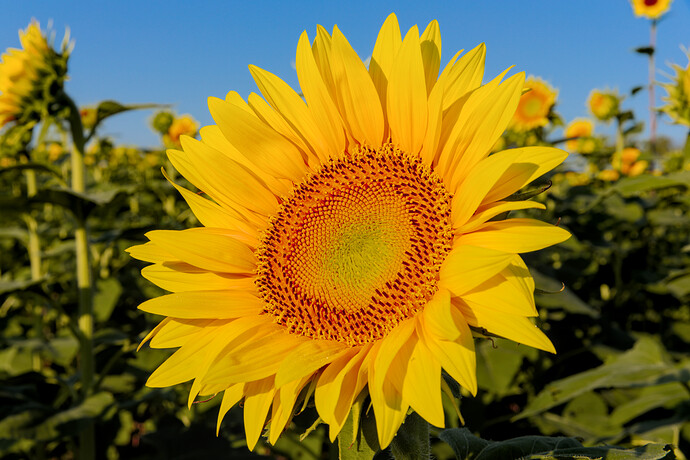random observations while I was toying with your image:
- you have highlight reconstruction enabled, yet nothing is clipped? (or is this because of a default in my config?)
- you have denoise on, while the shot is at iso 100? (or is this because of a default in my config?)
- I’m probably wrong on this: But I remember being told once that contrast-equalizer clips values above 1.0 so is not safe to use before filmic… this is wrong these days?
Anyway, after playing with your CR2 I didn’t see what the issue was… I was getting results I like more with filmic v6 vs v5 any way I tried it.
Then I loaded your filmic v5 XMP to load up ‘wait, what was he/she actually going for?’… and then ‘the issues’ started. I couldn’t match your v5 render anyway I tried.
What’s happening is that you actually WANT a hue shift. Both the in-camera JPEG that’s inside the CR2 as the pretty much default v5 and v6 rendering, all render the petals more ‘orange’, so yellow with a colorcast from the sun I imagine.
By setting filmic v5 to chromance-mode ‘no’, you actually disable some of the hue-preservation in v5 if I remember correctly, and the tone will shift to be more yellow if they become brighter.
This ‘misbehaviour’ is ‘fixed’ in v6, and it now always preserves hue, even with preserve-chrominance set to ‘no’. But in your case, this is not what you want. But it is what filmic and other modules set out to do: Preserve the hue of the data at all cost.
It sounds like you want to use more something like a color module to push to hue more towards yellow, and then use whatever tone-mapper you want :).
But… if this is something that’s working for you, fine, use it. Nothing wrong with it! Just know that the result what you are going for is ‘shifting away from the hue that is captured’ , so people normally try to prevent that.
As an example, the sigmoid-tonemapper also renders the leaves as the orange color… unless Iower it’s ‘preserve hue’ slider all the way to 0, and then ‘hey, it is just as your filmic v5 render!’.
Loaded your v5 version in a snapshot and started toying around, and quickly came to the conclusion that I had to do what you did in your v5 XMP to get close, at least to an extent:
- color balance rgb instance, masked to hz for hue to target the yellows, and hue-shift them more to yellow (away from golden orange).
- color balance rgb instance, masked to hz for blues and a bit of Jz to ignore shadows. Had a hard time to match your blue-ish-ness for the sky. In the end settled on the legacy mode to make some crude adjustments.
- color balance rgb instance, masked to hz for greens and Jz to ignore highlights, to get the background greens in a somewhat similar place
I ‘misused’ the filmic display tab (which I normall never do. Maybe play more with it. I right-clicked the target white luma and entered a high number (300% or so), so that the slider then goes to 300, and I can drag it around to get a feel and see what it does, settled on just over 200%. So I made filmic give a colorful look without ‘too much decolored whites’ in the yellow petals, then raised the display target to give it punch. The rest is pretty standard filmic v6 in luminanceY mode to be honest.
Added a local-contrast instance to boost details in the petals, kinda like a ‘clarity’ slider in other programs.
For the JPEG export I had diffuse x2 enabled for some sharpening, and denoise masked to chroma-only to get rid of chroma noise in the sky (kept the luma noise). In the XMP I don’t have them enabled / present.
0L0A3314_03.CR2.xmp (59.3 KB)
So, I sort of don’t know how to feel about this one :). If I just load your CR2 and look at the differences between filmic v5 and v6, I don’t find v5 superior at all. But if I want to go for the specific look you went for, I have to ‘misuse’ filmic-v5-no-mode which I consider more as a happy bug  , or like I showed in my XMP I push the hue towards where I want it and just use v6 like I normally do.
, or like I showed in my XMP I push the hue towards where I want it and just use v6 like I normally do.
In my head, I like the v6 workflow more. ‘I look at the image, I decide I want the petals to be more yellow, so I add color-balance to push them to yellow’. I don’t know if you just stumbled on the yellow color by accident or if it was a conscious decision. But if it was a real decision, then getting there ‘by accident’ in a very specific filmic v5 mode doesn’t feel right to me :). But if it’s works, it works!!!




 , or like I showed in my XMP I push the hue towards where I want it and just use v6 like I normally do.
, or like I showed in my XMP I push the hue towards where I want it and just use v6 like I normally do.




 .
.